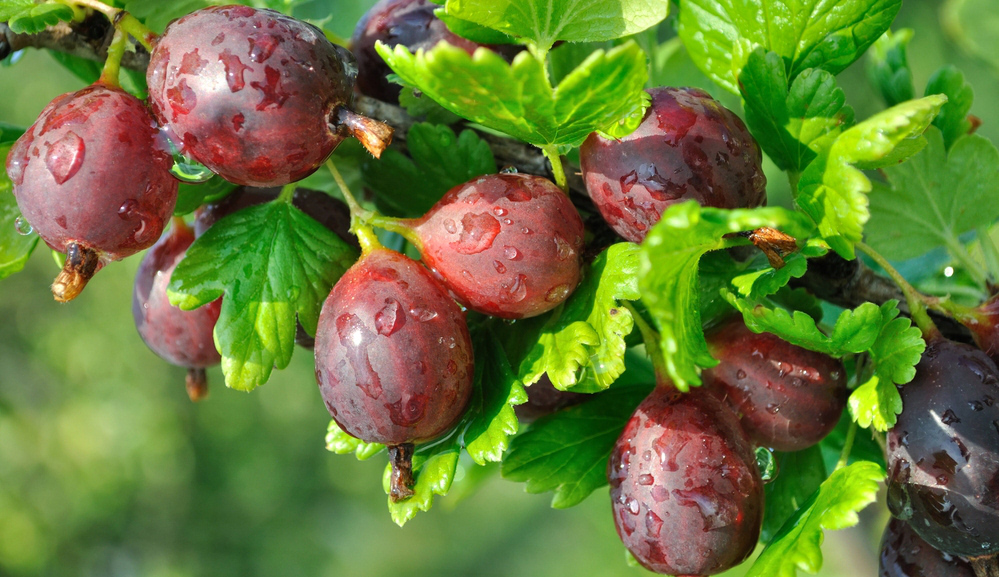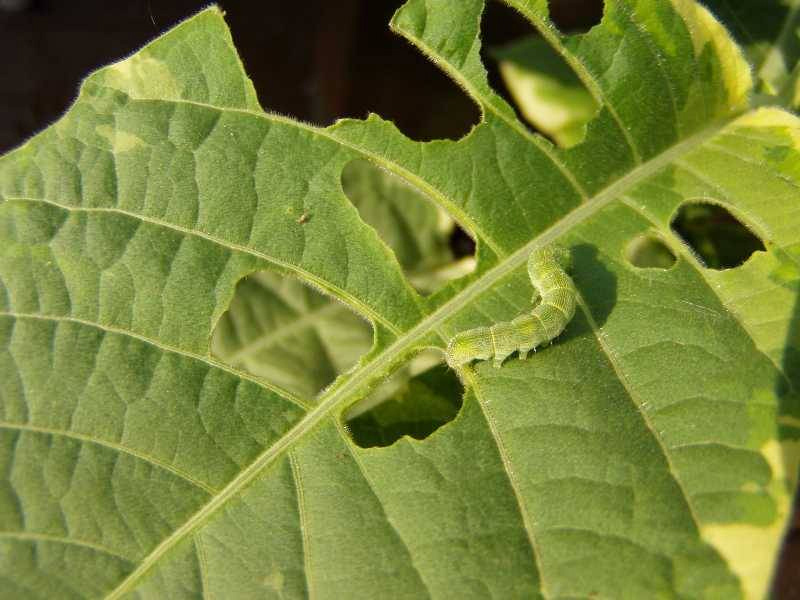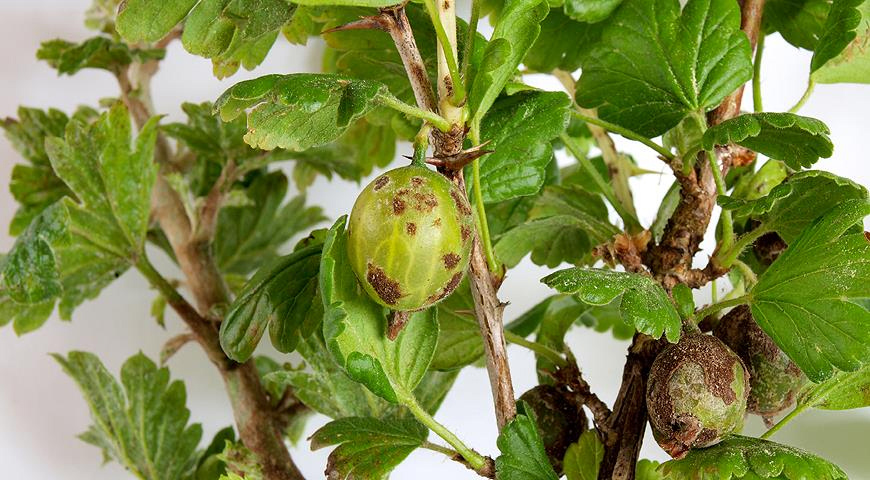Gooseberry caterpillars ate leaves, how to deal with pests
Content:
- Symptoms indicating that the plant has been attacked by pests
- Common pests on gooseberries and methods of dealing with them
- Pest prevention
The gooseberry is an excellent juicy berry common in vegetable gardens. Like any other plant, it can be attacked by pests. This attack must be fought, otherwise there is a risk of insect infection of the entire plant. Caterpillars that make the greatest contribution to the death of berry bushes are worth special attention. Below you can find detailed information on pest control.
Symptoms indicating that the plant has been attacked by pests
The symptoms of gooseberry disease will depend on which pest attacked the leaves of the berry bushes. Appearance is the main indicator of plant disease. Are the leaves starting to curl up? The shoot aphid may be the reason, it sucks the juice from the young leaves. A sign of the appearance of a pest will also be the formation of cobwebs and yellowing of the leaves, characteristic of the spider mite. This very small insect is difficult to spot, but despite its size, it does colossal damage. You may not even pay attention to how the plant begins to die rapidly.
Common pests on gooseberries and methods of dealing with them
If the caterpillars on the gooseberry have eaten the leaves, how to deal with the pest? Caterpillars carry a separate place in harm to plant health. Butterfly larvae hibernate under fallen leaves of trees, and in spring they wake up and leave their cocoons. At first, they feed on young buds and shoots. Each type of caterpillar is worth special attention.
Gooseberry fire
The gooseberry firefly eats not only the leaves of the gooseberry, but also the currant. The butterfly begins to lay its larvae already at the beginning of May inside a flower or young ovary. She can place 2 eggs in a bud at once. The body of the caterpillar is light green and the head is black. A sign of the attack of this insect is the cobweb, with which they capture several berries at once. The berries begin to turn red long before ripening, and after that they begin to rot. For a month of its life, one caterpillar eats up to 10 gooseberry berries. After their meal, they go downstairs to create even more dolls. New larvae grow in 1-1.5 weeks.
Control methods
In spring and autumn, it is important to dig up the ground under the bush and get rid of the foliage that has fallen under it. The larvae of the fire flies will be destroyed together with the foliage, even before they went to winter.
Together with other plants, gooseberries should be treated with infusions of wormwood and tomato tops during the season.
- half a bucket of blooming wormwood is needed for the solution;
- it needs to be filled with 10 liters of water;
- let the solution infuse for about a day, after which it must be boiled for 30 minutes;
- after that, the infusion should be cooled, filtered and diluted with water in proportions one to one;
- To make the product stick to the leaves, add 50 g of soap.
As a last resort, you can resort to chemical agents: karbofors, actellik and etafors.
Gooseberry sawfly and gooseberry moth
Sawflies have two types of false caterpillars: the first type is about 17 mm in length and has a green-bluish color, with a dark head. The second species is even smaller: about 10 mm, has the same color, but the head is already light in color. Why false caterpillars? The sawfly is not a butterfly. Its larvae are no less voracious than caterpillars, in just 2-3 days they are able to eat all the leaves of the bush. After the loss of foliage, the plant ceases to be capable of photosynthesis and slowly dies, at first the berries decrease in size, and then completely fall off.
The larvae survive the winter in the upper layers of the soil, just like the fireball. The insect lays from 80 to 140 eggs, after which a whole detachment of the same pests is born.
The gooseberry moth is not inferior in the amount of losses to sawflies. Its offspring are colored mainly white; closer to the abdomen, the color changes to orange. The body of the larva is covered with black spots, and the head has the same color. The parasite is about 4 centimeters long. In a cocoon of cobwebs, they survive the winter and begin to eat a large number of buds. Caterpillars pupate during the flowering season. After sitting for about a month in the pupa, the butterfly hatches and lays eggs on the back of the leaf.
What to do when green caterpillars in gooseberry berries
As in the case of the fire, before and after the season, you need to carefully dig up the soil, about 15 centimeters. In summer, the caterpillars are shaken off the leaves, laying a film under the bush. Insects are destroyed by boiling water.
As before, 2 types of solutions can be used. The recipe for bitter wormwood is written above, the following will be the preparation of infusion from tomato tops:
- you need 4 kg of tomato tops;
- you need to fill them with 10 liters of water;
- everything is boiled for about an hour over low heat;
- having filtered the product, it can be used to protect the bushes. Dilute with water in proportions of three liters to ten liters of water;
- a little soap is added before use.
Glass-maker
This pest applies to both gooseberries and currants. Light-colored larvae survive the winter not in the soil, but inside the tree and branches. They are about 20 mm long. When pruning gooseberry branches in spring, you can find their moves.
At the beginning of spring, the pupal stage takes place. In late spring or early summer, bee-like adults wake up. The butterfly begins to lay eggs again in lesions on the bark of the tree and at the base of the buds. The babies hatched into the world are capable of destroying the branches of the bush with renewed vigor. Inexperienced gardeners do not even suspect that the glass bowl eats about half of the branches. At first they wither, and after a while they become dry and break easily. The fruits almost never die, but they become much smaller.
Control methods
At the beginning and end of the season, it is important to carry out sanitary pruning of branches, after which they are burned to eradicate the parasite.
The soil of the plant can be sprinkled with a solution of tobacco and ash. You need to mix 350 g of ash, 200 g of tobacco and add 1 tablespoon of mustard and pepper. 3 tablespoons of the mixture are poured under each bush.
Currant gall midge
Gall midges are small mosquitoes that lay their larvae inside the bush. From the very beginning of spring, the gall midge lays the larvae on the youngest leaves. Gall midges are shoot and leaf. As the name suggests, they differ in the place where the larvae are laid.Leaves affected by insects become dry and gradually wrinkle, from the fact that they lose their juice. Branches affected by another detachment will be dry and brittle by autumn.
Ways to fight
In order to get rid of the pest, you need to prune the branches in autumn and winter, remove the leaves under the bush and burn it all. The soil is dug up to further eradicate gall midges.
Also, a gooseberry lover is scared off by mint and tomatoes. It is allowed to plant mint nearby or use an infusion of tomato tops. In case of severe damage to plants, you can resort to chemical agents karbofos, fufanon.
Currant goldfish
First of all, this beetle begins to damage the branches of the bush. White larvae eat away the core of the stem, gradually moving lower and lower. After being damaged by this parasite, gooseberry berries become small and lethargic. The currant goldfish hibernates inside the bark, in the same place it turns into a pupa.
The beetle begins to crawl out of the shoots during late spring and early summer. After 10 days at large, females lay their eggs on the bark and on the leaf stalks. They protect their offspring with a shield created from the female's glands, after which the clutch becomes almost invisible. After 2 weeks, the larvae appear and destroy the plant.
Control methods
Timely pruning of bush branches and harvesting leaves will save the harvest. If the bush is just preparing for planting, you should make sure that it is healthy. Insecticides can help with a large number of pests. They can be easily purchased at the store.
Kidney mite: if all the leaves of the gooseberry have been eaten, what to do
After the invasion of kidney mites, problems with the leaves occur. Such a pest is not large, but it is very dangerous for the garden. These mites have a worm-like body, with two pairs of paws. It is difficult to see the parasite with the naked eye: the maximum length is only 2 millimeters.
In this situation, the enemy is terrible in its number. In one kidney there can be about 10 thousand larvae, which will instantly eat everything. This number of species is provided by the huge fecundity of the female: during her life she can deposit about 200 thousand new kidney mites. The tick easily infects not only other buds of the bush, but also other plants. After a raid of such mites, the leaves become ugly and sick.
Control methods
Due to the small size of the pest, it is difficult to detect, but still real. When the buds begin to bloom in the spring, it is worth examining them for the presence of rounded subspecies. If such are found, they are removed from the stem. With an abundance of such heads of cabbage, you will need to remove the entire stem.
There is a solution that drives away the larvae. For it, either 200 g of crushed garlic is used, or 300 g of onion husks, diluted in 10 liters of water. Let the solution infuse, and then it can be used for weekly processing.
Spider mite
A distinctive feature of this mite is the entanglement of plants with cobwebs. The insect appears in early spring. Having chosen its place of residence and part-time place of meal, the spider mite braids the leaf with cobwebs. It feeds on the juice of the leaves. Depleted leaves turn yellow, and later die altogether.
Like kidney mites, they are fertile. Females are able to lay about 7 generations and are microscopic in size. They hibernate in the same way as all pests, under the ground and in fallen leaves.
If the gooseberry leaves are eaten, what to do
Ticks do not like the smell of tobacco, so there is a recipe for a solution from it: 400 g of tobacco is poured with 10 liters of hot water. You need to let this water brew for about two days, and then you can process the plants with it. You can also add soap for better adhesion. It is also permissible to use a tincture of bitter wormwood.
If folk methods do not help get rid of gooseberry fans, it is worth resorting to chemicals. Bushes are processed before flowering or after harvest.
Sprout aphid
Aphids are considered the most common pest. It begins its development from the stalks of young leaves, and drinks their juice.
After development, some larvae transform into winged females, and capture new young shoots. The leaves after such an invasion become withered and deformed. In subsequent years, the leaves will develop poorly and the shoot aphid colonies will flourish.
Ways to fight
As in the case of ticks, in early spring the bush is doused with hot water, which will simply boil the pest.
You can use the folk tinctures of onion and garlic, given in the example of the kidney mite. Onions and garlic should be planted next to the bushes.
Potato leaf tincture recipe:
- you need to use a kilogram of green potato tops. Or you can use 700 grams already dry;
- tops are poured with 10 liters of hot water, and let it infuse;
- it's time to process the bushes with a solution.
In more rare cases, chemical agents can be used: Spark, fufanon and others.
Pest prevention
The best solution to pest control is prevention.
Gooseberries need to be constantly inspected, remove weeds next to them and take care of the soil under them. It is necessary to carry out pruning annually so that the air passes calmly to the plant.
Some gardeners plant pest repellent plants next to the bushes: mint, tomatoes, onions or garlic. It is worth pouring hot water over the shrubs with the onset of spring. This will prevent parasitic insects from waking up in time.
The garden will need comfort and safety. By protecting the plants, it will be possible to harvest the gooseberry beautifully in the future. There are many pests that love this bush, but each of them has its own opposition.




























